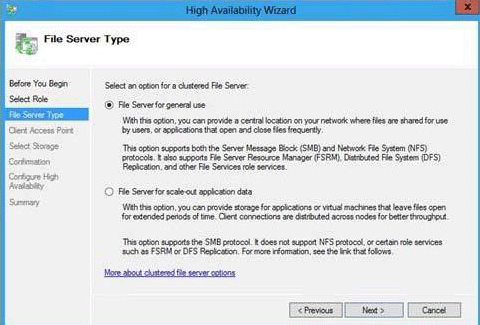- All Exams Instant Download
What should you configure?
Your network contains an Active Directory domain named contoso.com. The domain contains two member servers named Server1 and Server2. All servers run Windows Server 2012 R2. Server1 and Server2 have the Failover Clustering feature installed. The servers are configured as nodes in a failover cluster named Cluster1. You add two additional nodes in Cluster1. You have a folder named Folder1 on Server1 that hosts Application data. Folder1 is a folder target in a Distributed File System (DFS) namespace. You need to provide highly available access to Folder1. The solution must support DFS Replication to Folder1.
What should you configure?
A . Affinity-None
B . Affinity-Single
C . The cluster quorum settings
D . The failover settings
E . A file server for general use
F . The Handling priority
G . The host priority
H . Live migration
. The possible owner
. The preferred owner
. Quick migration
. The Scale-Out File Server
Answer: E
Explanation:
File Server for general use

Note: You can deploy and configure a clustered file server by using either of the following methods:
* File Server for general use.
This is the continuation of the clustered file server that has been supported in Windows Server since the introduction of Failover Clustering. This type of clustered file server, and therefore all the shares associated with the clustered file server, is online on one node at a time. This is sometimes referred to as active-passive or dual-active. File shares associated with this type of clustered file server are called clustered file shares. This is the recommended file server type when deploying information worker scenarios.
* Scale-Out File Server for application data
This clustered file server feature was introduced in Windows Server 2012, and it lets you store server application data, such as Hyper-V virtual machine files, on file shares, and obtain a similar level of reliability, availability, manageability, and high performance that you would expect from a storage area network. All file shares are simultaneously online on all nodes. File shares associated with this type of clustered file server are called scale-out file shares. This is sometimes referred to as active-active. This is the recommended file server type when deploying either Hyper-V over Server Message Block (SMB) or Microsoft SQL Server over SMB.
Reference: Scale-Out File Server for Application Data Overview
Latest 70-412 Dumps Valid Version with 448 Q&As
Latest And Valid Q&A | Instant Download | Once Fail, Full Refund
Subscribe
Login
0 Comments
Inline Feedbacks
View all comments

